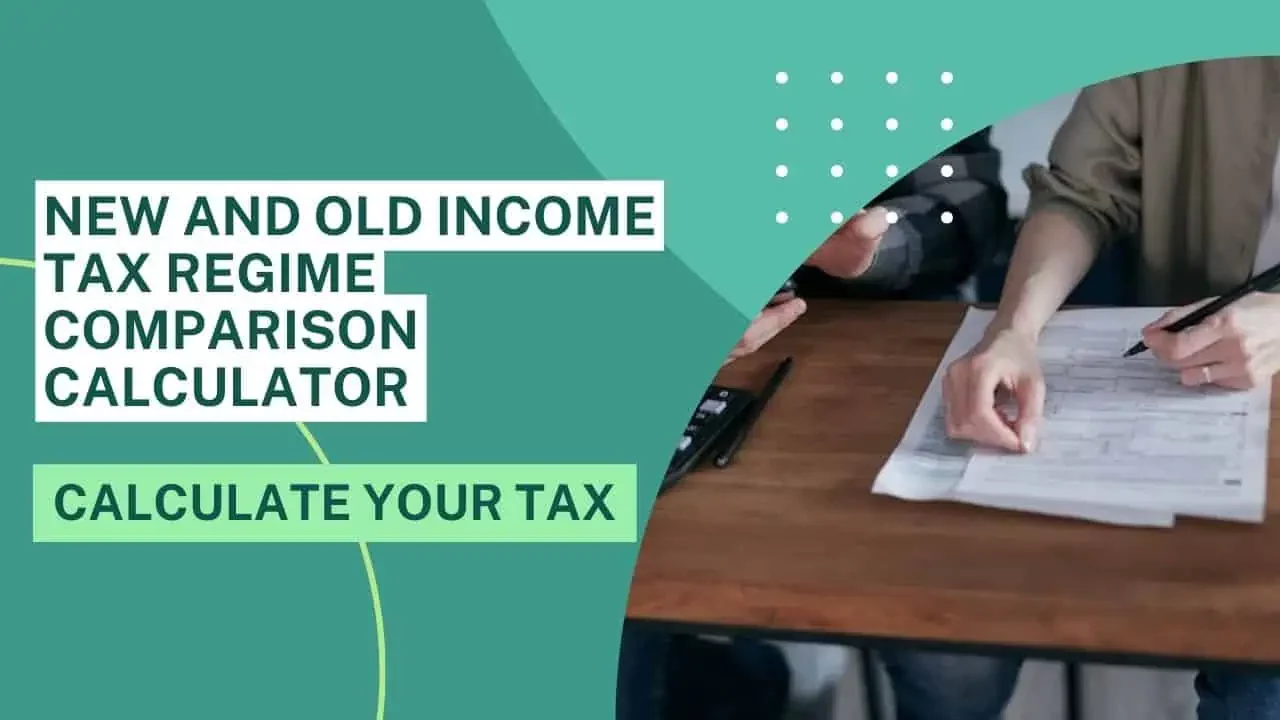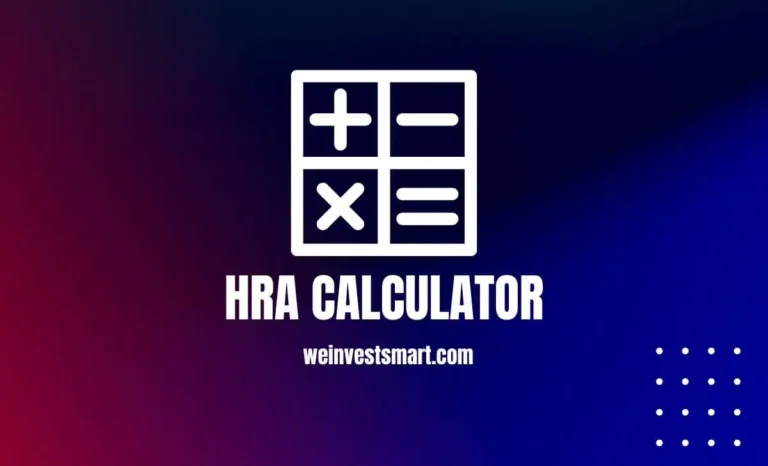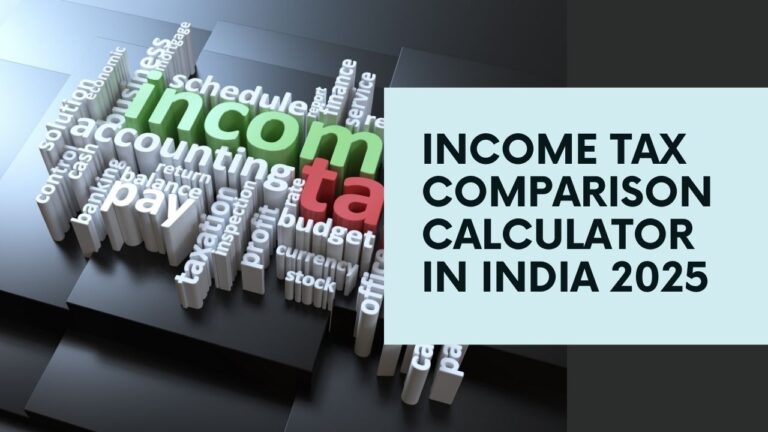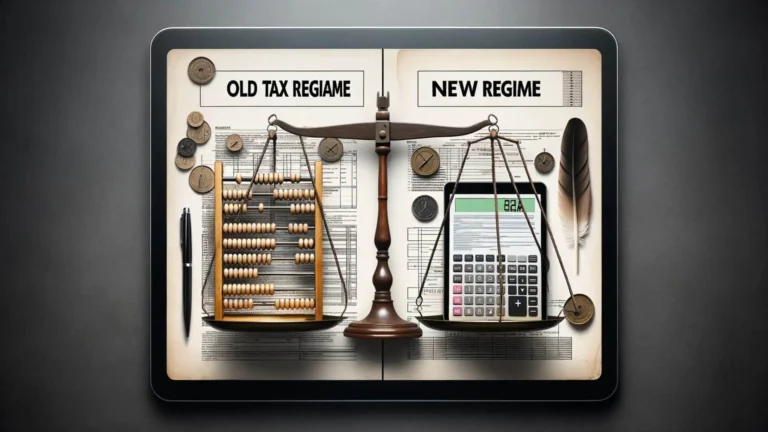New and Old Income Tax Regime Comparison Calculator FY 24-25 : Choose the Best Tax Regime
This post was most recently updated on April 2nd, 2024
Filing income tax returns can be a tedious and confusing task, especially with the introduction of a new income tax regime. The new tax regime was introduced in 2020 and offers lower tax rates but without the benefit of certain deductions and exemptions. To help taxpayers make an informed decision, we have developed a new and old income tax regime comparison calculator.

This calculator is a useful tool that allows taxpayers to compare their tax liabilities under the old and new regimes and choose the one that is most beneficial for them. In this article, we will explore the features and benefits of using a new and old income tax regime comparison calculator.
In this blog post, We will also discuss how this tool can help you make an informed decision and save money on taxes. Whether you’re a salaried individual or a business owner, the new and old income tax regime comparison calculator can simplify your tax planning process.
Read on to learn more about the income tax slabs for FY24–25, understand the differences in the new tax regime and the old tax regime and choose the best option for yourself.
Consider reading: Income tax exemptions for salaried employees
Consider reading this Reddit post on How to save maximum tax.
Page Contents
New and Old Income Tax Regime Comparison Calculator: Overview of Income Tax Regimes
India’s taxation system offers two distinct income tax regimes for individual taxpayers: the Old Regime and the New Regime. The Old Regime, a long-standing feature of India’s Income Tax Act, allows for various deductions and exemptions, enabling taxpayers to lower their taxable income through specific investments and expenses. This regime operates on a slab system with varying rates.
In contrast, the New Regime, introduced in the 2020 budget, presents a streamlined approach to taxation. This regime features lower tax rates but limits the availability of deductions and exemptions. It provides flexibility as taxpayers can choose between the Old and New Regime each tax year, depending on which is more beneficial for their financial situation.
However, the choice between the Old and New Regime is not one-size-fits-all. Taxpayers need to analyze their financial circumstances, considering factors like investments, expenses eligible for deductions, and income slabs, to make an informed decision. Opting for the New Regime may be advantageous for those with minimal deductions and exemptions, while the Old Regime might be better suited for taxpayers with significant deductible expenses.
Consider reading: difference between the old and new tax regime.
Tax Slab Rates in the New and Old Income Tax Regimes in India in FY 24-25
The tax rates under the old tax regime in India are as below:
| Taxable Income (INR) | Tax Rate |
|---|---|
| Up to 2,50,000 | 0% |
| 2,50,001 to 5,00,000 | 5% |
| 5,00,001 to 10,00,000 | 20% |
| Above 10,00,000 | 30% |
In the old tax regime, taxpayers could go for income tax exemptions and deductions.
The tax rates in the new tax regime updated with Budget 2023 tax slabs in India are as below:
| Taxable Income (INR) | Tax Rate |
|---|---|
| Up to 3,00,000 | 0% |
| 3,00,001 to 6,00,000 | 5% |
| 6,00,001 to 9,00,000 | 10% |
| 9,00,001 to 12,00,000 | 15% |
| 12,00,001 to 15,00,000 | 20% |
| Above 15,00,000 | 30% |
Please note that in the new tax regime, Taxable income up to INR 7,00,000 is tax-free.
Please note that these tax rates apply to individuals who are below the age of 60 years. For senior citizens (age 60 years or above but below 80 years) and very senior citizens (age 80 years or above), there are different tax rates and slabs.
It is also important to note that, under the new tax regime, deductions and exemptions are not available. However, taxpayers can claim a standard deduction of INR 52,500 for salary income and INR 40,000 for pension income.
Consider reading: Old Vs New Tax Regime – Which is Better?
Which is Best for Saving the Most Tax Between the New and Old Tax Regimes?
If you want to save maximum tax, then go for the old tax regime, as it offers tax savings instruments using which you can save maximum tax.
The new tax regime is for those who do not want to put their money into tax savings instruments.
Final Thoughts on New and Old Income Tax Regime Comparison Calculator
In the ever-evolving financial landscape of India, the distinction between the new and old income tax regimes stands out. Both regimes have their merits, tailored to suit different taxpayer profiles.
While the old system offers a myriad of deductions and exemptions, the new regime simplifies the structure with reduced tax rates and minimal exemptions. As taxpayers, it’s imperative to be informed and make a choice that aligns with our financial goals.
Use our New and Old Income Tax Regime Comparison Calculator to check which regime is best for you and how much tax you can save.
Remember, understanding the nuances between the new and old income tax regimes can lead to informed decisions, ensuring you make the most of your hard-earned money.
Keep abreast of the latest updates and consider consulting a tax expert if in doubt. After all, when it comes to taxation in India, knowledge is not just power—it’s savings!
FAQs on New and Old Income Tax Regime Comparison Calculator
Can I switch between the old and new regimes from one year to the next?
No, once you have chosen a particular tax regime for a particular financial year (April 1 to March 31), you are required to stick to it for that entire year. You cannot switch between the old and new regimes from one year to the next. However, you have the option to choose a different tax regime in the following year.
Are there any restrictions on who can opt for the new tax regime?
There are no restrictions on who can opt for the new tax regime. Any individual (including salaried employees, self-employed individuals, and pensioners) can choose the new tax regime if they wish to do so. However, it is important to carefully evaluate the pros and cons of both the old and new tax regimes before making a decision on which one to choose.
Can I claim deductions and exemptions under the new tax regime?
No, under the new tax regime, deductions and exemptions are not available. However, taxpayers can claim a standard deduction of INR 50,000 for salary income and INR 40,000 for pension income.
How to compare old vs new tax regime calculator?
To compare old vs new tax regime calculator, you can follow these steps: 1. Gather your income details and tax deductions for both regimes. 2. Use an online tax calculator that supports both old and new slabs. 3. Enter your income and deductions in the calculator. 4. Compare the tax liability for both regimes and assess the difference. This will help you understand the impact of the new tax regime on your finances.
Which income tax regime is better old or new?
The new tax regime, as per the revisions in the Union Budget 2023, is designated as the default. However, taxpayers can choose the old tax regime if they prefer. It is important to note that the new system does not allow for various exemptions and deductions, such as HRA, LTA, 80C, 80D, etc. Ultimately, the choice between the old and new regime depends on individual circumstances and financial goals.
What is the tax rate for 40 lakh salary?
The tax rate for a salary of ₹40 lakh in India is 38.3%. This means that if you earn ₹4,000,000 per year, your net pay will be ₹2,467,000, or ₹205,583 per month, after deducting ₹1,533,000 in taxes. The marginal tax rate for this income level is 43.2%
How do I calculate my income tax?
Calculate your income tax by summing up your income from all sources to find your gross income. Deduct allowable exemptions to arrive at your taxable income. Choose between the New and Old tax regimes, each with different slab rates. Apply the relevant slab rates to your taxable income and include cess to determine your net tax liability. Always refer to the latest income tax slabs for accurate calculations.
How to calculate income tax on salary for fy 2023 24?
To calculate income tax on salary for FY 2023-24, determine your total income and apply the relevant rates from the new tax regime. No tax for income below Rs 3 lakh, 5% for Rs 3-6 lakh, 10% for Rs 6-9 lakh, and so forth. Deduct permissible deductions and declare investments to ascertain your taxable income. Use the income tax calculator or consult the latest slabs for precise computation.
How do you calculate total income in income tax?
Total income in income tax is calculated by subtracting eligible deductions from your Gross Total Income (GTI). This includes deductions under various sections of the Income Tax Act, like Section 80C for investment in tax-saving instruments, ensuring your reported income reflects actual taxable earnings.





